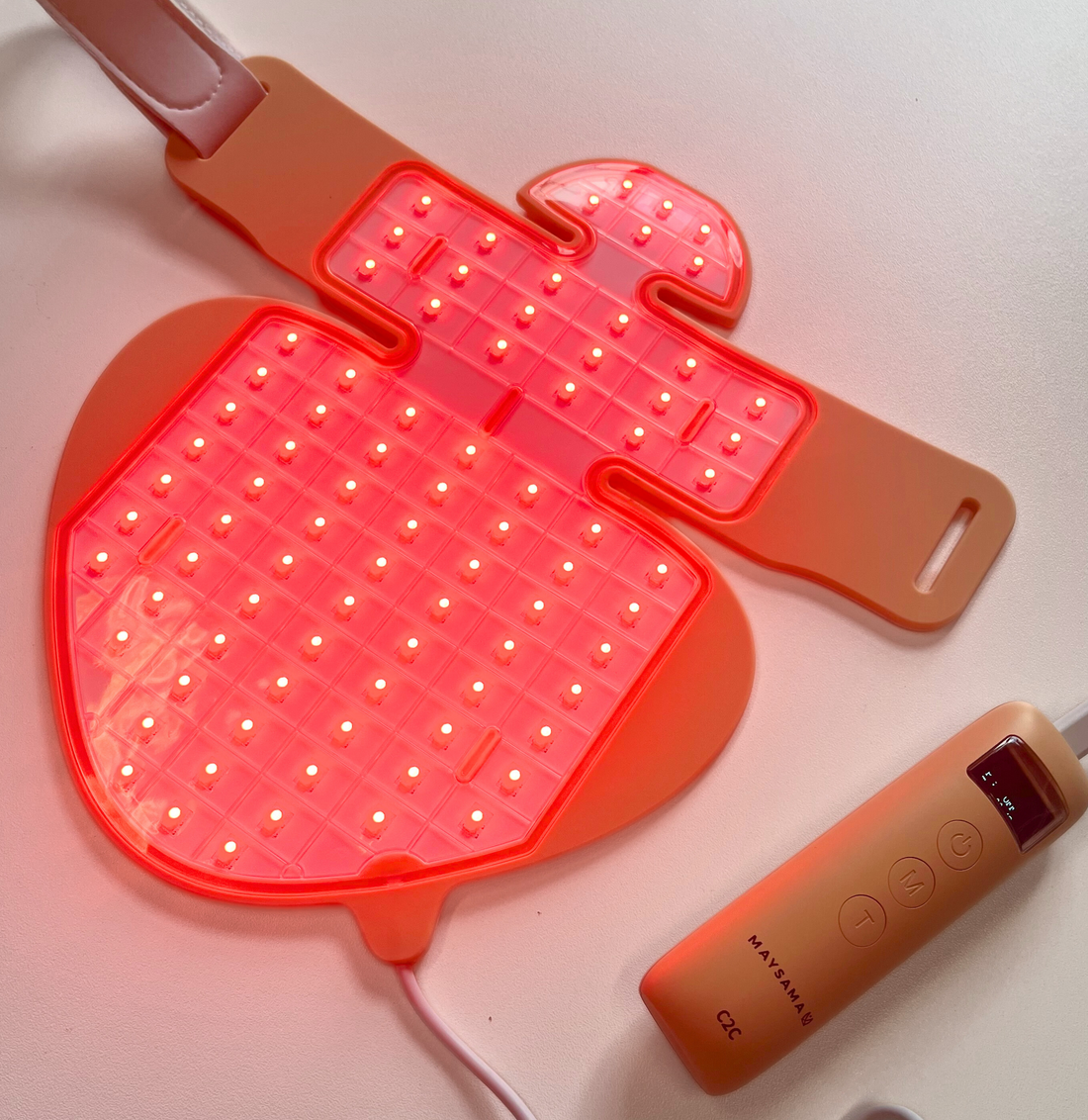
Red Light Therapy for Bruises: Accelerate Healing with LED Devices
Share
Bruises are more than just surface marks. Whether from sports, everyday accidents, or cosmetic treatments, they can bring swelling, soreness, and lasting discolouration that takes weeks to fade.
But what if you could support your body’s natural healing processes, reduce discomfort, and restore normal skin tone more quickly, all with a gentle, non-invasive light treatment at home?
That is where red light therapy for bruises comes in. Growing research shows that targeted exposure to red and near-infrared light can reduce inflammation, improve circulation, and speed up tissue repair.
In this article, we explore how red light therapy helps bruises heal faster, the scientific evidence behind it, and how Maysama’s LED devices, particularly the flexible LED Light Therapy Silicone Belt, can make at-home recovery simpler and more effective.
What Happens During a Bruise and Why Healing Can Take Time

A bruise, or contusion, occurs when tiny blood vessels (capillaries) under the skin rupture due to impact, allowing red blood cells and plasma to leak into nearby tissues. The immune system responds with inflammation and cell signalling to clear the pooled blood and repair the damaged vessels.
As haemoglobin in the leaked blood breaks down into biliverdin, bilirubin, and hemosiderin, the bruise changes colour from purple to green to yellow before fading completely.
While most bruises heal within one to three weeks, deeper or larger ones can linger longer. Factors like age, poor circulation, and medication can slow the body’s repair mechanisms.
Red light therapy can help by stimulating these biological processes and improving blood flow and cellular energy.
The Science of Red Light Therapy for Bruises

How Photobiomodulation Aids Bruise Repair
Red light therapy, also known as photobiomodulation (PBM), uses specific wavelengths of visible red and near-infrared light (typically 600–900 nm) to stimulate cellular activity.
These wavelengths are absorbed by chromophores such as cytochrome c oxidase within mitochondria, displacing nitric oxide and restoring efficient electron transport.
This process increases ATP production, improving the energy available for cellular repair and regeneration.
In the case of bruising, PBM helps by:
- Reducing inflammation and oxidative stress, which supports faster resolution of swelling
- Enhancing microcirculation and vascular repair to clear trapped blood cells and deliver nutrients
- Stimulating fibroblast and keratinocyte activity, which aids collagen production and tissue remodelling
- Promoting angiogenesis (new capillary formation), which is essential for the recovery of the affected tissue
In other words, red light therapy does not just camouflage bruises – it accelerates the body’s natural healing response.
Evidence Supporting Red Light Therapy for Bruising
While large clinical trials on bruises are limited, existing studies and case reports show consistent benefits:
- A case study found that a 660 nm LED treatment applied for 10 minutes accelerated the fading of bruise discolouration compared with untreated skin.
- Animal and surgical models show that photobiomodulation reduces oedema, enhances vascular perfusion, and speeds tissue recovery after trauma.
- Clinical reports describe faster bruise fading and reduced pain when LED therapy is used soon after injury.
- Broader reviews of PBM confirm consistent benefits for tissue repair, inflammation control, and circulation improvements.
Collectively, the research suggests that using red light therapy for bruises is a safe, evidence-supported way to help the body heal faster.
How to Use Red Light Therapy for Bruises Safely and Effectively

To get meaningful benefits without risks, here are practical guidelines:
Timing: When to Begin
When using red light therapy for bruises, timing plays an important role in achieving the best results. It is best to start treatment as soon as any active bleeding has stopped, usually within a few hours to a day after the injury.
Beginning early helps calm inflammation and promotes faster clearance of pooled blood under the skin.
However, you should avoid using red light therapy while the area is still actively bleeding, as increased circulation at that stage could worsen the leakage. Once the bruise has stabilised, continue daily or alternate-day sessions for several days or weeks until the discolouration has noticeably improved.
Wavelengths and Dosage
For optimal results, use red light in the 630–670 nm range along with near-infrared light around 800–850 nm, which penetrates deeper into tissue. The typical therapeutic dose is between 4 and 20 joules per square centimetre, depending on the device’s power output.
Sessions usually last between 5 and 20 minutes for each treated area. In the first few days, one or two sessions per day can be beneficial, tapering to fewer sessions as the bruise heals.
Distance and Contact
Maintaining correct positioning is also essential. Keep the device at the effective distance or spacing recommended by the manufacturer to ensure the light reaches the skin efficiently. Make sure the entire bruised area receives full light exposure, including a small margin around the edges, to promote even healing.
Precautions
There are a few precautions to keep in mind. Avoid shining the device directly into your eyes, and wear protective goggles during use. Do not apply red light therapy to open wounds, burns, or areas that are still bleeding.
If you take blood thinners, have a clotting disorder, or suffer from vascular disease, consult a healthcare professional before beginning treatment. Likewise, seek medical advice if a bruise is unusually large, very painful, or slow to resolve.
Finally, remember that more light is not necessarily better; research shows that photobiomodulation follows a biphasic dose response, meaning excessive exposure can actually reduce therapeutic benefits.
Integrating Maysama Devices into Bruise Healing
Maysama’s LED devices are designed to make home treatment both safe and effective. Their use of Pulsed LED technology improves light absorption while preventing overstimulation, offering a more balanced biological response.
Why the Belt Is Particularly Helpful

The LED Light Therapy Silicone Belt is ideal for treating bruises because of its flexible design and dual-wavelength system. The belt can wrap comfortably around limbs, torso, or other affected areas, delivering both red and near-infrared light across a broad surface.
The soft silicone ensures consistent contact without pressure, which is important for sensitive or tender skin.
It also allows for hands-free use, making daily sessions simple to fit into your routine. You can use the belt alone or pair it with the LED Light Therapy Mask for facial bruising, or the Chin2Chest LED Light Therapy Device for neck or chest areas.
Benefits You Can Expect
With consistent use, users often report faster fading of discolouration, reduced tenderness, and less swelling. This improvement is due to enhanced circulation, faster clearance of blood pigments, and improved collagen repair. Over time, skin texture and tone also appear more even.
While individual results vary depending on bruise size, depth, and personal health factors, many people notice visible improvement several days earlier than they would expect without light therapy.
Best Practices to Support Healing

For optimal results, combine red light therapy with traditional self-care measures. Rest the affected area and protect it from further injury.
Apply cold compresses in the first few hours to limit swelling, then transition to gentle warmth to promote blood flow. Keep the area elevated when possible to reduce fluid accumulation and ensure you stay hydrated.
Good nutrition also supports healing: vitamin C, vitamin K, and antioxidants help maintain strong blood vessels and skin resilience.
Pairing red light therapy with Maysama’s antioxidant-rich skincare products containing Green Rooibos Extract can further reduce oxidative stress and support the skin’s recovery process.
Limitations and Considerations
Although red light therapy provides measurable support in bruise recovery, it is not a medical substitute. Deep tissue hematomas, large contusions, or persistent pain should always be evaluated by a healthcare professional.
Outcomes also depend on device quality and consistent use. Maysama’s products are designed for reliability and comfort, with clinically informed wavelengths that ensure safe, effective home use.
A Practical Example
Imagine you accidentally knock your shin against furniture, creating a painful purple bruise.
Within the first few hours, you rest the area and apply a cold pack. By the next day, bleeding has stopped, so you wrap the Maysama LED Belt around your lower leg and start a 10-minute light session.
You repeat this once daily for three days, then every other day for a week. The bruise lightens quickly, swelling subsides, and within ten days, your skin looks normal again.
Final Thoughts
Red light therapy for bruises is a gentle, scientifically supported way to help your body recover faster and more comfortably.
By improving circulation, reducing inflammation, and energising cells at the site of injury, LED light therapy encourages quicker clearance of bruising and restores natural skin tone.
Maysama’s range of Pulsed LED Light Therapy devices, particularly the LED Light Therapy Silicone Belt, offers a convenient, effective method to harness these benefits from home.
Used consistently and correctly, it can shorten healing time, reduce tenderness, and leave skin looking clearer and healthier, helping you feel better, faster.




